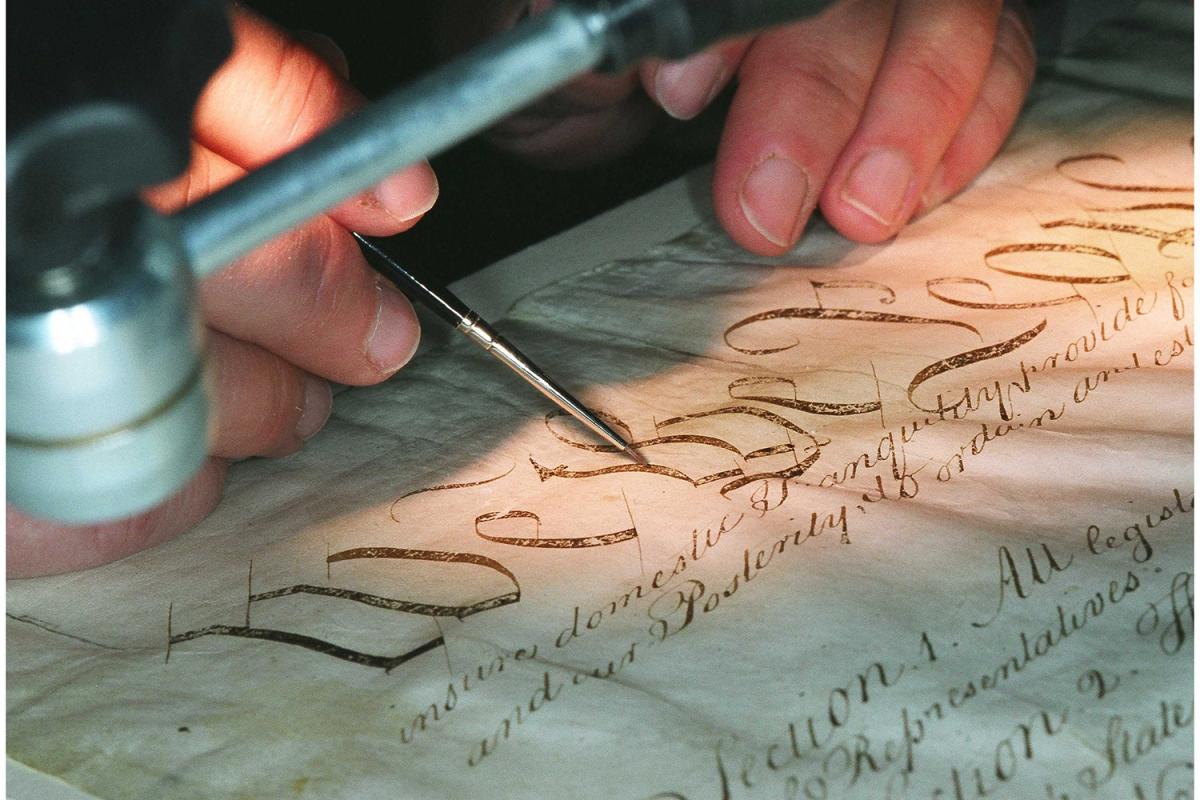
National Archives Reflects on Last 20 Years of Preserving the Founding Documents
By National Archives Staff
WASHINGTON, September 15, 2023 — Analysis over the last several years by the National Archives shows that encasements installed to display the Founding Documents 20 years ago continue to fulfill their role in safeguarding these fragile historical records.
“We’re really pleased with how the cases are performing to protect the Declaration of Independence, the Constitution, and the Bill of Rights,” said Chris Naylor, Executive for Research Services. “The Rotunda encasements ensure that these documents can remain on permanent display and will be around for future generations to experience.”
To safely display the Founding Documents for public viewing, the National Archives exhibits them at low light levels and in specially built metal and glass encasements in the Rotunda.
These display cases are filled with argon to provide an oxygen-free, or anoxic (here defined as a target of less than 0.5% oxygen, compared to 21% in air), environment to prevent document deterioration.
Data obtained from oxygen-monitoring sensors on the displays shows that five of the encasements have maintained their oxygen-free environment since they were sealed 20 years ago. These house the Declaration of Independence and Constitution (pages 1, 2, 3, and the Transmittal Page).
Two encasements have oxygen levels above 1%, which is the upper limit of the sensors used. These contain the Bill of Rights and page 4 of the Constitution.
“Our work at the National Archives requires balancing the missions of preservation and access,” said Sarah Stauderman, Deputy Director of Preservation Programs. “In the short term, our scientists believe that the elevated oxygen levels will have little impact on these two documents, and we can keep them on permanent display.”
In addition to the special encasements and anoxic conditions, the Rotunda’s light level (less than 3 footcandles) helps protect the documents from light-induced changes, even if the documents are at a normal atmospheric oxygen level, Stauderman explained.
Data shows that other conditions like temperature and relative humidity have held steady within design specifications over the encasement lifetime.
How the Encasements Work
The National Institute of Standards and Technology (NIST) designed and constructed the encasements and a monitoring system, which were installed during a major renovation of the National Archives Building in 2001–2003.
At that time, the Founding Documents were removed from the housings in which they had been encased since the 1950s.
Conservators carefully examined and treated the documents before they were placed in the new encasements and returned to exhibit on Constitution Day, September 17, 2003.
While the 1950s-era encasements were filled with helium to provide an environment free of oxygen, the 2003 encasements use argon gas, which is a larger inert gas molecule and is therefore easier to contain.
How We Measure the Data
Over the past 20 years, conservators and heritage scientists have periodically measured the oxygen levels of the Founding Document encasements.
In 2015, the National Archives collaborated with NIST and the Library of Congress to develop new and improved oxygen sensors for the challenging task of monitoring oxygen at anoxic concentrations.
To collect a measurement, an encasement is removed from exhibit, the sensor is attached, and the oxygen levels are monitored for a minimum of several hours to obtain stable readings.
The monitoring must be performed at night because the Founding Documents are on permanent exhibit, and the sensor cannot remain on the encasement during display.
The closure of the Rotunda early in the COVID-19 pandemic provided opportunities in 2020 and 2021 to collect data on each encasement for much longer times and obtain more accurate results.
“When our building was closed to the public, we could assess our work and perform more comprehensive testing,” said Lindsay Oakley, Director of Heritage Science Research and Testing. “The results reassured us that the majority of the encasements are functioning as designed. We plan to conduct additional research to understand more fully their interior anoxic environment and to direct our next steps for the two encasements with higher oxygen levels.”
Future Preservation of the Founding Documents
The National Archives intends to study the gasses inside the encasements for signs of volatile degradation products produced by the documents.
This analysis will use a newly acquired gas chromatography-mass spectroscopy system and a sampling procedure developed by the Library of Congress.
In addition, the National Archives is developing experiments with a new microfading system, which will allow agency scientists to study how ink fades in oxygen-free environments.
These studies will help the National Archives better understand the effect of long-term oxygen-free environments and make informed decisions about how to care for the Founding Documents.
These studies will also address deliberation within the preservation field about the use of anoxic environments for permanent exhibition.
Unlike the 1950s-era housings, the NIST-designed encasements on display now can be flushed with humidified argon to restore the anoxic conditions, if that is deemed necessary, or alternatively, to modify the environment if research supports changes.
This study and potential argon re-flushing of the encasements are planned to be completed by the end of 2024.
As recently announced, the National Archives is renovating its permanent galleries ahead of the celebration of the 250th anniversary of the Declaration of Independence in 2026. Some exhibit areas were closed on July 5, 2023, and will reopen in the summer of 2025. The Rotunda will remain open throughout the project.

